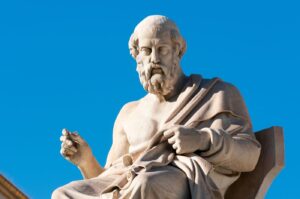Adherents of monotheistic religions often find it hard to take ancient polytheistic religions seriously. Although we are grateful to Greece and Rome for bequeathing us the literature and art that their religions helped to inspire, it seems to us that the Greeks and Romans had too many gods, and that their gods were too much like mortals to be taken seriously. We find it hard to swallow the idea that intelligent Romans could have believed in gods who were unconstrained by human moral codes, and who spent most of their endless lives sitting on top of Mt. Olympus, drinking nectar and eating ambrosia to sustain their eternal youth.
Perhaps it is the emphasis the Romans placed on physical demonstrations of belief, like participation in sacrifices (as opposed to internalized belief), that has encouraged historians of Greek and Roman religion to conclude that belief was not required. But in fact outward religious observance became a matter of life and death: at least until 312 A.D. (when the Roman emperor Constantine became a convert to Christianity), the Romans had no qualms about persecuting people who refused to honor the traditional gods with sacrifices and rituals. After the fall of the Roman republic, the pantheon of gods was thought to include their current emperor, so it was considered a capital offense not to acknowledge, accept, or honor his divinity. Christians who refused to perform the required rites were persecuted, and many were grilled alive or gored or eaten by wild animals as entertainment before live audiences, in theaters and stadiums throughout the Roman Empire. In other words, if Romans performed sacrifices in the approved manner, it did not matter what they believed about the nature—or even the existence—of the gods.
In Belief and Cult: Rethinking Roman Religion, Jacob Mackey makes the opposite case. He argues that participation in ritual necessarily implies that the celebrants believed in their gods. Or (to put it another way) he suggests that most Romans would not have participated in rituals honoring their gods if they had not believed in those gods. But how can we know what they thought if they do not tell us? No adherent of traditional Roman religion seems to have written a counterpart to St. Augustine’s Confessions, with its vivid description of how he converted to Christianity. The closest pagan equivalent is Apuleius’s novel Metamorphoses (also known as The Golden Ass), with its detailed account of how a rather profligate young man decided to become a celibate priest of the Egyptian goddess Isis.
Roman Credo
To demonstrate that cult does not exist without belief, Mackey turns first to common sense. The Romans had a word for belief, credo, from which the English words creed and credible derive. So the problem is not whether the Romans believed in their gods, but rather our inability to understand how the Romans chose to express that belief.
Start your day with Public Discourse
Sign up and get our daily essays sent straight to your inbox.Of course, Mackey knows that it is difficult for us moderns to grasp the Roman manner of belief. How could sophisticated Romans in the first century B.C., like Cicero or Horace, suppose that offerings placed near statues could influence the gods? How could they have thought that examining the entrails of sacrificed animals, or watching the flights of birds, could reliably guide their actions? Did they really believe that the gods would look favorably upon ritual dancing and singing? Did Roman religion really consist of doing, rather than believing, as some prominent scholars have suggested?
It is perhaps natural that we should ask ourselves such questions, because of the emphasis that the religions of the book (Judaism, Christianity, and Islam) place on theology and the interpretation of sacred texts. But Mackey shows that in Roman religion, action was not empty ritual, but rather the principal means of demonstrating belief. Such action included processions and performing sacrifices where gods inhaled the smoke and mortals ate the meat of the sacrificial victims. Roman religion also encouraged mortals to make likenesses of their gods (a practice explicitly forbidden in the Ten Commandments of Judaism), and offer gods expensive gifts (which were stored in temples).
All this suggests that the Romans worshiped their gods by doing stuff, rather than by studying religious writings or by pious reflection. For Romans, piety (pietas) meant following a system of rules. In modern theoretical terminology, it was a deontology, or do-what-you-ought-to-do-ism. Priests supervised their group actions. They also interpreted prodigia, remarkable events such as visions and epiphanies. Flight of birds and the animal entrails served as warnings about the future.
How could sophisticated Romans in the first century B.C., like Cicero or Horace, suppose that offerings placed near statues could influence the gods? How could they have thought that examining the entrails of sacrificed animals, or watching the flights of birds, could reliably guide their actions?
Theories of Belief
Mackey fortifies his argument by discussing modern theories about human religious activity. These theories suggest that people do not do things (especially things that involve large outlays of time and money) unless they believe that what they are doing serves some purpose. Ancient writers, of course, could not have known about these theories. But human psychology does not appear to have changed radically since ancient times—which is one reason we continue to read ancient texts.
Mackey also points to the resilience of popular religious belief among ancient Romans as evidence that their beliefs were sincere. The poet Lucretius explained that humans had come to believe in the existence of gods because they had seen the gods in visions and dreams. Despair was a powerful motivation for prayer and ritual action. In fact, everything in the known world had come into existence because the atoms had swerved into each other and formed larger entities. Dreams and visions were formed of atoms thrown off from real events; the gods existed but were not involved in human life. But despite Lucretius’s efforts, most Romans continued to believe that the gods depicted in traditional myths truly did intervene in human life, and therefore required honor and worship.
Roman children learned about religious practice in the same way that they learned to talk: by imitation. There was no equivalent of a Sunday school because there was no equivalent of the Bible. Sacrifices were family affairs, not unlike barbecues—everyone got to eat some of the sacrificial meat. Sacrifices also provided a means of communicating with the relevant divinities, who were thought to be present at the feasts.
Despite Lucretius’s efforts, most Romans continued to believe that the gods depicted in traditional myths truly did intervene in human life, and therefore required honor and worship.
Theory Can’t Substitute for Facts
To illustrate the seriousness of Roman religious beliefs, Mackey draws primarily on literary texts and art. But he could also have found supporting documentation on inscriptions from even long after the advent of Christianity. Texts found in the far reaches of the Roman Empire testify to the importance of participating in sacrifices. One example is an inscription on a stone plaque that is now in a museum on Patmos, an island in the Eastern Mediterranean (where, around two centuries before the inscription, the New Testament Book of Revelation was written). The physician’s inscription is dedicated to the goddess Artemis to commemorate his young daughter Vera’s role in a sacrifice, in which she brought the goddess an offering of embryos from a newly killed goat, in gratitude for her protection. Gruesome as such sacrifices may now seem to us, they were a fundamental element of Roman (and ancient Greek) religion, providing humans a means of communion with the divinities, as well as nourishment for themselves—it was primarily in such ritual settings that most people had an opportunity to eat meat. Song was also an important element of worship. Children, both boys and girls, sang in choruses celebrating the gods, imploring them for protection. An ancient mosaic depicting a children’s chorus is on the book’s dust jacket.
In addressing the question of belief, Mackey has made a valuable contribution to our understanding of Roman religion. His discussion of literary texts is interesting and instructive. But I would have found his discussion of Roman religion even more persuasive if he had spent more time discussing ancient documents and less time explaining modern theories of belief and practice. Such theories seem too abstract and hypothetical to help us make sense of the fragmented and disparate information we have about the ancient Roman world.
Perhaps terms like “deontic,” “emic,” and “etic” may have resonance or meaning in our own times, when we are overwhelmed with information. But ancient evidence about ancient belief and practice is not so plentiful as we would like it to be. Surviving illustrations and writings rarely tell us what participants thought and felt when they were worshiping the gods. But theory is not an adequate substitute for the many facts about the ancient past that we are unlikely ever to recover.










